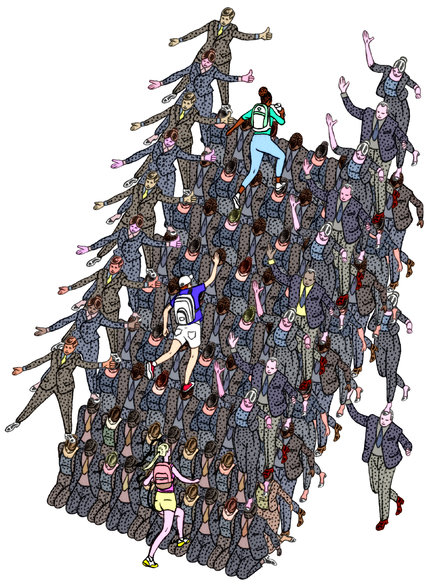To many graduating students in the United States, their professors “fall low on the ladder of meaningful contacts,” says an Emory University English professor in “What’s the Point of a Professor,” a provocative opinion piece in the May 9, 2015 issue of
The New York Times.
“Oh, they’re quite content with their teachers,” says Mark Bauerlein, who is also senior editor at the online journal
First Things and author of the recent book
The Dumbest Generation: How the Digital Age Stupefies Young Americans and Jeopardizes Our Future (or, Don’t Trust Anyone Under 30). “After all, most students receive sure approval. In 1960, only 15 percent of grades were in the ‘A’ range, but now the rate is 43 percent, making ‘A’ the most common grade by far.”
Then Bauerlein jabs the stinger: “But while they’re content with teachers, students aren’t much interested in them as thinkers and mentors. They enroll in courses and complete assignments, but further engagement is minimal.”
 ART BY TIM ENTHOVEN THE NEW YORK TIMES
ART BY TIM ENTHOVEN THE NEW YORK TIMESBauerlein says that the reason for this is that teachers can’t become a moral authority if they rarely challenge students in class and engage them beyond it: “If we professors do not do that, the course is not an induction of eager minds into an enlarging vision. It is a requirement to fulfill. Only our assistance with assignments matters. When it comes to students, we shall have only one authority: the grades we give. We become not a fearsome mind or a moral light, a role model or inspiration. We become accreditors.”
He argues that professors have too meager interaction with their students outside of class: “It’s often during incidental conversations held after the bell rings and away from the demands of the syllabus that the transfer of insight begins and a student’s emulation grows. Students email teachers all the time — why walk across campus when you can fire a note from your room? — but those queries are too curt for genuine mentoring. We need face time.”
But how much face time do students actually get from their professors: “For a majority of undergraduates, beyond the two and a half hours per week in class, contact ranges from negligible to non-existent,” Bauerline says. “In their first year, 33 percent of students report that they never talk with professors outside of class, while 42 percent do so only sometimes. Seniors lower that disengagement rate only a bit, with 25 percent never talking to professors, and 40 percent sometimes.”
Bauerline laments that professors pressed for research time and career advancement don’t want to engage with their students that much, either: “As a result, most undergraduates never know that stage of development when a learned mind enthralled them and they progressed toward a fuller identity through admiration of and struggle with a role model.”
Read Mark Bauerlein’s “What’s the Point of a Professor” in The New York Times now!